Halo alkanes and haloarenes
Download as pptx, pdf0 likes163 views
This chemistry document discusses the preparation of various organic compounds from alcohols, alkenes, and haloalkanes. It also covers the properties of haloalkanes and the preparation of haloarenes from diazonium chloride.
1 of 17
Download to read offline
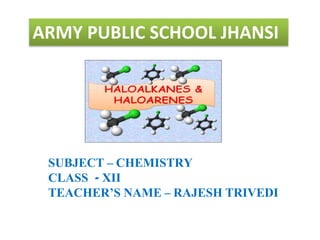
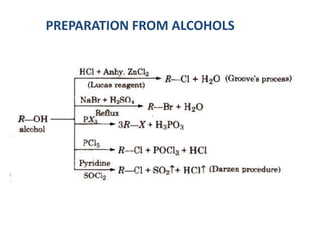

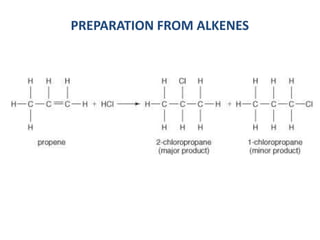
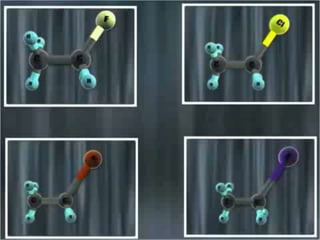


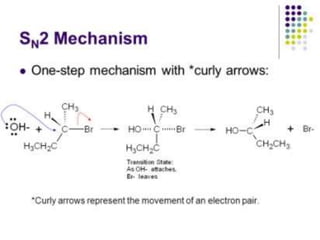

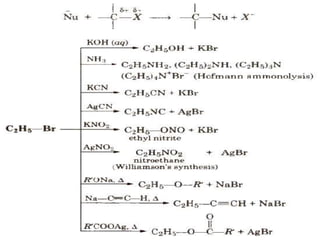
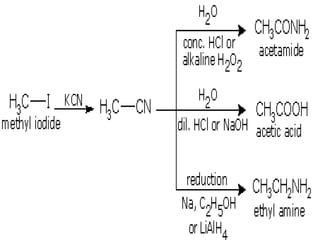
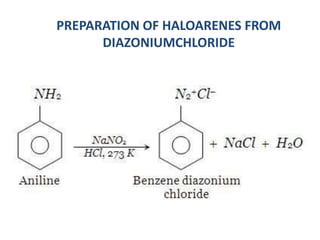
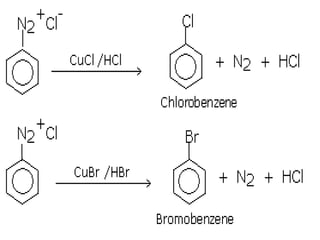

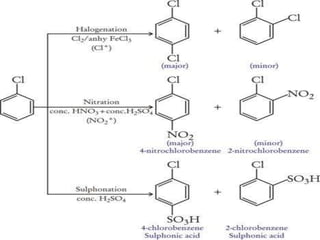

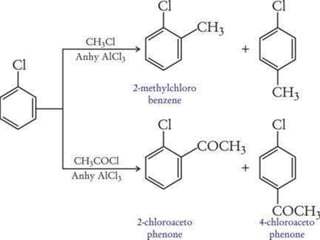
Ad
Recommended
Alcohols, phenol & ethers
Alcohols, phenol & ethersRajeshTrivedi15
╠²
This document discusses the classification, properties, reactions, and industrial preparation of alcohols and phenols. It classifies alcohols based on their structure as primary, secondary or tertiary alcohols. It also classifies them based on the number of -OH groups they contain. The document discusses industrial preparation methods for alcohols like hydroboration oxidation. It also discusses common chemical reactions of alcohols like combustion, esterification and Victor Meyer test. For phenols, it discusses methods of preparation from chlorobenzene, Grignard reagent, benzene sulphonic acid, aniline and cumene. It also explains reactions of phenols like oxidation, KolbeAlcohols, phenol & ethers
Alcohols, phenol & ethersRajeshTrivedi15
╠²
This document provides information about alcohols, phenols, and ethers. It discusses the classification of alcohols based on their structure and number of OH groups. Methods for the industrial preparation and properties of alcohols are described. Phenol can be prepared from chlorobenzene, Grignard reagents, benzene sulphonic acid, aniline, and cumene. Reactions of phenol including oxidation, Kolbe reaction, and Reimer-Tiemann reaction are covered. The final section discusses the reaction of ethoxyethane with chlorine.Alcohols, phenol & ethers
Alcohols, phenol & ethersRajeshTrivedi15
╠²
1. The document is about alcohols, phenols, and ethers from a chemistry class. It discusses the classification, properties, reactions, and industrial preparation of alcohols.
2. Methods for preparing phenol are outlined, including from chlorobenzene, Grignard reagents, benzene sulphonic acid, aniline, and cumene. Oxidation reactions of phenol and mechanisms for Kolbe and Reimer-Tiemann reactions are described.
3. The final section discusses the reaction of ethoxyethane with chlorine.Alcohols, phenol & ethers
Alcohols, phenol & ethersRajeshTrivedi15
╠²
The document is about alcohols, phenols, and ethers from a chemistry class. It discusses the classification, properties, preparation, and reactions of alcohols. It also covers the preparation methods, oxidation, and reactions of phenol, including the Kolbe and Reimer-Tiemann reactions. The document concludes by mentioning the reaction of ethoxyethane with chlorine.Chemical kinetics
Chemical kineticsRajeshTrivedi15
╠²
This chemistry document discusses key concepts in chemical kinetics including the average and instantaneous rates of reaction, how the order of a reaction relates to its molecularity, and the characteristics and relationships between half time period and concentration for reactions of various orders. It covers topics like first order, second order, zero order reactions and how their rates are affected by changes in concentration.Electro chem
Electro chemRajeshTrivedi15
╠²
This document provides an overview of electrochemistry concepts including:
- The differences between electrolytic and galvanic cells and how they convert between chemical and electrical energy.
- How standard electrode potentials are measured and used to determine the electrode potential of other electrodes relative to the standard hydrogen electrode.
- How galvanic cells work and the relationship between electrode potentials and the overall cell potential.
- The electrochemical series and how it arranges electrodes by their reduction potentials.
- How corrosion occurs via electrochemical reactions and how the presence of more or less reactive metals affects the corrosion of iron.
- Examples of primary batteries like dry cells and secondary batteries like lead-acid batteries, including their cell reactions.Ppt some bsc concpt xi
Ppt some bsc concpt xiRajeshTrivedi15
╠²
The document outlines basic concepts of chemistry for Class XI at Army Public School Jhansi. The subject is taught by Rajesh Trivedi. It serves as an educational resource for students learning chemistry.Atomic structure ppt
Atomic structure pptRajeshTrivedi15
╠²
Rutherford's experiment discovered the nucleus of the atom and disproved Thomson's plum pudding model. It bombarded a thin gold foil with alpha particles and observed that most particles passed through but some were deflected at very large angles, indicating a small, massive center of the atom now called the nucleus. The document then discusses electronic configurations and 3-D structures of s, p, and d orbitals according to the Aufbau principle and hydrogen spectrum.PPT Atomic structure by Rajesh Trivedi
PPT Atomic structure by Rajesh TrivediRajeshTrivedi15
╠²
Rutherford's experiment discovered the nucleus of the atom and disproved Thomson's plum pudding model. It bombarded a thin gold foil with alpha particles and observed that most particles passed through but some were deflected at very large angles, indicating a small, massive center of the atom now called the nucleus. The document then discusses electronic configurations and 3-D structures of s, p, and d orbitals according to the Aufbau principle and hydrogen spectrum.Test paper solution Rajesh Trivedi
Test paper solution Rajesh Trivedi RajeshTrivedi15
╠²
This document provides a test paper containing one mark and two mark questions related to concepts in solutions and colligative properties:
1. The one mark questions cover calculating normality of H2SO4, when Vant Hoff's factor is greater than one, how freezing point and boiling point depression relate to solute molecular mass, moles of NaCl in a solution, and Van't Hoff's factor for non-electrolytes.
2. The two mark questions involve calculating freezing point depression of a non-electrolyte solution, amount of urea that will separate from a cooled solution, molar mass from a boiling point elevation experiment, and boiling point of an NaCl solution and molarity andTest paper solid state Rajesh trivedi
Test paper solid state Rajesh trivedi RajeshTrivedi15
╠²
This document contains a test paper on solid state physics concepts with one mark and two mark questions. The one mark questions cover topics like coordination number of crystal structures, crystal defects, radius ratios for ion occupation of tetrahedral sites, and properties of unit cells. The two mark questions cover calculating Avogadro's number from crystal lattice parameters and density, calculating unit cells in a sample mass, explaining Schottky defects and packing efficiency, and discussing F centers, doping, effects of Frenkel defects, and conductivity changes with temperature.Test paper solid state Rajesh trivedi
Test paper solid state Rajesh trivedi RajeshTrivedi15
╠²
This document contains a test paper with one mark and two mark questions about solid state physics concepts. The one mark questions cover topics like coordination numbers of crystal structures, crystal defects, and radius ratios for ion occupation of tetrahedral sites. The two mark questions ask about calculating Avogadro's number using crystal lattice information, calculating the number of unit cells in a given mass of a material, explaining Schottky defects and packing efficiency, and discussing F centers, doping, and the effects of temperature on defects and conductivity.The Solid state PPT Rajesh Trivedi
The Solid state PPT Rajesh TrivediRajeshTrivedi15
╠²
The document provides an overview of solid state chemistry concepts for a class XII curriculum, including topics such as unit cells, types of packing arrangements, and the properties of solids. It covers the number of atoms per unit cell, defects, and electrical and magnetic properties based on band theory. Various exercises are included to reinforce understanding of key concepts.Halo alkanes and haloarenes PPT Rajesh Trivedi
Halo alkanes and haloarenes PPT Rajesh Trivedi RajeshTrivedi15
╠²
This chemistry document discusses the preparation of various organic compounds from alcohols, alkenes, and haloalkanes. It also covers the properties of haloalkanes and the preparation of haloarenes from diazonium chloride.Electro chemistry PPT Rajesh Trivedi
Electro chemistry PPT Rajesh TrivediRajeshTrivedi15
╠²
The document covers various topics in electrochemistry for a chemistry class, including electrolytic and galvanic cells, electrode potential, and the Nernst equation. It explains concepts such as corrosion, battery types (primary and secondary), and fuel cells, along with exercises for assessment. It also includes various electrochemical reactions and their applications.Chemical kinetics PPT Rajesh Trivedi
Chemical kinetics PPT Rajesh TrivediRajeshTrivedi15
╠²
This document outlines topics in chemical kinetics for a Chemistry class taught by Rajesh Trivedi at Army Public School Jhansi. It covers key concepts including average and instantaneous rates of reaction, molecularity versus order of reaction, and characteristics of different reaction orders. Additionally, it discusses the relationship between half-life periods and concentration for various reaction orders.Alcohols, phenol & ethers
Alcohols, phenol & ethersRajeshTrivedi15
╠²
The document is about alcohols, phenols, and ethers from a chemistry class. It discusses the classification, properties, preparation, and reactions of alcohols. It also covers the preparation methods, oxidation, and reactions of phenol, including the Kolbe and Reimer-Tiemann reactions. The document concludes by mentioning the reaction of ethoxyethane with chlorine.Solution PPT Rajesh Trivedi
Solution PPT Rajesh TrivediRajeshTrivedi15
╠²
This document contains notes from a chemistry class on various topics related to solutions and colligative properties, including molality, molarity, mole fraction, Raoult's law, elevation of boiling point, depression of freezing point, and the van't Hoff factor. It provides definitions and equations for calculating properties like boiling point elevation and freezing point depression based on factors like the molal elevation constant, weights of solute and solvent, and molecular weights. Relationships between the van't Hoff factor and the degree of association or dissociation of solutes are also discussed.Non-Communicable Diseases and National Health Programs ŌĆō Unit 10 | B.Sc Nursi...
Non-Communicable Diseases and National Health Programs ŌĆō Unit 10 | B.Sc Nursi...RAKESH SAJJAN
╠²
This PowerPoint presentation is prepared for Unit 10 ŌĆō Non-Communicable Diseases and National Health Programs, as per the 5th Semester B.Sc Nursing syllabus outlined by the Indian Nursing Council (INC) under the subject Community Health Nursing ŌĆō I.
This unit focuses on equipping students with knowledge of the causes, prevention, and control of non-communicable diseases (NCDs), which are a major public health challenge in India. The presentation emphasizes the nurseŌĆÖs role in early detection, screening, management, and referral services under national-level programs.
¤ö╣ Key Topics Included:
Definition, burden, and impact of NCDs in India
Epidemiology, risk factors, signs/symptoms, prevention, and management of:
Diabetes Mellitus
Hypertension
Cardiovascular Diseases
Stroke & Obesity
Thyroid Disorders
Blindness
Deafness
Injuries and Accidents (incl. road traffic injuries and trauma guidelines)
NCD-2 Cancers:
Breast Cancer
Cervical Cancer
Oral Cancer
Risk factors, screening, diagnosis, early signs, referral & palliative care
Role of nurse in screening, referral, counseling, and continuum of care
National Programs:
National Program for Prevention and Control of Cancer, Diabetes, Cardiovascular Diseases and Stroke (NPCDCS)
National Program for Control of Blindness
National Program for Prevention and Control of Deafness
National Tobacco Control Program (NTCP)
Introduction to Universal Health Coverage and Ayushman Bharat
Use of standard treatment protocols and referral flowcharts
This presentation is ideal for:
Classroom lectures, field assignments, health education planning, and student projects
Preparing for university exams, class tests, and community field postingsPaper 107 | From Watchdog to Lapdog: IshiguroŌĆÖs Fiction and the Rise of ŌĆ£Godi...
Paper 107 | From Watchdog to Lapdog: IshiguroŌĆÖs Fiction and the Rise of ŌĆ£Godi...Rajdeep Bavaliya
╠²
Dive into a captivating analysis where Kazuo IshiguroŌĆÖs nuanced fiction meets the stark realities of postŌĆæ2014 Indian journalism. Uncover how ŌĆ£Godi MediaŌĆØ turned from watchdog to lapdog, echoing the moral compromises of IshiguroŌĆÖs protagonists. WeŌĆÖll draw parallels between restrained narrative silences and sensationalist headlinesŌĆöare our media heroes or traitors? DonŌĆÖt forget to follow for more deep dives!
M.A. Sem - 2 | Presentation
Presentation Season - 2
Paper - 107: The Twentieth Century Literature: From World War II to the End of the Century
Submitted Date: April 4, 2025
Paper Name: The Twentieth Century Literature: From World War II to the End of the Century
Topic: From Watchdog to Lapdog: IshiguroŌĆÖs Fiction and the Rise of ŌĆ£Godi MediaŌĆØ in Post-2014 Indian Journalism
[Please copy the link and paste it into any web browser to access the content.]
Video Link: https://youtu.be/kIEqwzhHJ54
For a more in-depth discussion of this presentation, please visit the full blog post at the following link: https://rajdeepbavaliya2.blogspot.com/2025/04/from-watchdog-to-lapdog-ishiguro-s-fiction-and-the-rise-of-godi-media-in-post-2014-indian-journalism.html
Please visit this blog to explore additional presentations from this season:
Hashtags:
#GodiMedia #Ishiguro #MediaEthics #WatchdogVsLapdog #IndianJournalism #PressFreedom #LiteraryCritique #AnArtistOfTheFloatingWorld #MediaCapture #KazuoIshiguro
Keyword Tags:
Godi Media, Ishiguro fiction, post-2014 Indian journalism, media capture, Kazuo Ishiguro analysis, watchdog to lapdog, press freedom India, media ethics, literature and media, An Artist of the Floating WorldSustainable Innovation with Immersive Learning
Sustainable Innovation with Immersive LearningLeonel Morgado
╠²
Prof. Leonel and Prof. Dennis approached educational uses, practices, and strategies of using immersion as a lens to interpret, design, and planning educational activities in a sustainable way. Rather than one-off gimmicks, the intent is to enable instructors (and institutions) to be able to include them in their regular activities, including the ability to evaluate and redesign them.
Immersion as a phenomenon enables interpreting pedagogical activities in a learning-agnostic way: you take a stance on the learning theory to follow, and leverage immersion to envision and guide your practice.Environmental Science, Environmental Health, and Sanitation ŌĆō Unit 3 | B.Sc N...
Environmental Science, Environmental Health, and Sanitation ŌĆō Unit 3 | B.Sc N...RAKESH SAJJAN
╠²
This PowerPoint presentation covers Unit 3 ŌĆō Environmental Science, Environmental Health, and Sanitation from the 5th Semester B.Sc Nursing syllabus prescribed by the Indian Nursing Council (INC). It is carefully designed to support nursing students, educators, and community health professionals in understanding the environmental components that influence health and disease prevention.
The unit emphasizes the interrelationship between the environment and human health, highlighting various environmental factors, hazards, and strategies for disease prevention through sanitation and public health initiatives.
Ō£│’ĖÅ Topics Covered in the PPT:
Definition and scope of environmental science and environmental health
Importance of a safe environment for public health
Types of environmental pollution ŌĆō air, water, soil, noise, and radiation
Sources, effects, and prevention of different types of pollution
Concept of ecosystem and its components
Water safety and purification methods at household and community levels
Disposal of waste and excreta ŌĆō types, methods, health risks
Introduction to environmental sanitation
Vector control measures: Mosquitoes, houseflies, rodents, etc.
Biological and non-biological health hazards in the environment
National programs related to environmental health and sanitation
Health education for safe water, hygiene, and sanitation behavior change
Role of a community health nurse in promoting environmental health
Use of community bags and home visit kits to educate rural families
Practical methods for solid waste management and waste segregation
This presentation supports:
Class lectures and revision
Health teaching in field visits
Community awareness campaigns
Internal assessments and final exam preparation
It ensures that all essential environmental health concepts are simplified and well-structured for easy understanding and application in nursing practice.How to Manage Different Customer Addresses in Odoo 18 Accounting
How to Manage Different Customer Addresses in Odoo 18 AccountingCeline George
╠²
A business often have customers with multiple locations such as office, warehouse, home addresses and this feature allows us to associate with different addresses with each customer streamlining the process of creating sales order invoices and delivery orders.How to Customize Quotation Layouts in Odoo 18
How to Customize Quotation Layouts in Odoo 18Celine George
╠²
Customizing quotation layouts in Odoo 18 allows businesses to personalize their quotations to match branding or specific requirements. This can include adding logos, custom fields, or modifying headers and footers. GEOGRAPHY-Study Material [ Class 10th] .pdf
GEOGRAPHY-Study Material [ Class 10th] .pdfSHERAZ AHMAD LONE
╠²
"Geography Study Material for Class 10th" provides a comprehensive and easy-to-understand resource for key topics like Resources & Development, Water Resources, Agriculture, Minerals & Energy, Manufacturing Industries, and Lifelines of the National Economy. Designed as per the latest NCERT/JKBOSE syllabus, it includes notes, maps, diagrams, and MODEL question Paper to help students excel in exams. Whether revising for exams or strengthening conceptual clarity, this material ensures effective learning and high scores. Perfect for last-minute revisions and structured study sessions.Assisting Individuals and Families to Promote and Maintain Health ŌĆō Unit 7 | ...
Assisting Individuals and Families to Promote and Maintain Health ŌĆō Unit 7 | ...RAKESH SAJJAN
╠²
This PowerPoint presentation is based on Unit 7 ŌĆō Assisting Individuals and Families to Promote and Maintain Their Health, a core topic in Community Health Nursing ŌĆō I for 5th Semester B.Sc Nursing students, as per the Indian Nursing Council (INC) guidelines.
The unit emphasizes the nurseŌĆÖs role in family-centered care, early detection of health problems, health promotion, and appropriate referrals, especially in the context of home visits and community outreach. It also strengthens the studentŌĆÖs understanding of nursing responsibilities in real-life community settings.
¤ōś Key Topics Covered in the Presentation:
Introduction to family health care: needs, principles, and objectives
Assessment of health needs of individuals, families, and groups
Observation and documentation during home visits and field assessments
Identifying risk factors: environmental, behavioral, genetic, and social
Conducting growth and development monitoring in infants and children
Recording and observing:
Milestones of development
Menstrual health and reproductive cycle
Temperature, blood pressure, and vital signs
General physical appearance and personal hygiene
Social assessment: understanding family dynamics, occupation, income, living conditions
Health education and counseling for individuals and families
Guidelines for early detection and referral of communicable and non-communicable diseases
Maintenance of family health records and individual health cards
Assisting families with:
Maternal and child care
Elderly and chronic disease management
Hygiene and nutrition guidance
Utilization of community resources ŌĆō referral linkages, support services, and local health programs
Role of nurse in coordinating care, advocating for vulnerable individuals, and empowering families
Promoting self-care and family participation in disease prevention and health maintenance
This presentation is highly useful for:
Nursing students preparing for internal exams, university theory papers, or community postings
Health educators conducting family teaching sessions
Students conducting fieldwork and project work during community postings
Public health nurses and outreach workers dealing with preventive, promotive, and rehabilitative care
ItŌĆÖs structured in a step-by-step format, featuring tables, case examples, and simplified explanations tailored for easy understanding and classroom delivery.SCHIZOPHRENIA OTHER PSYCHOTIC DISORDER LIKE Persistent delusion/Capgras syndr...
SCHIZOPHRENIA OTHER PSYCHOTIC DISORDER LIKE Persistent delusion/Capgras syndr...parmarjuli1412
╠²
SCHIZOPHRENIA INCLUDED TOPIC IS INTRODUCTION, DEFINITION OF GENERAL TERM IN PSYCHIATRIC, THEN DIFINITION OF SCHIZOPHRENIA, EPIDERMIOLOGY, ETIOLOGICAL FACTORS, CLINICAL FEATURE(SIGN AND SYMPTOMS OF SCHIZOPHRENIA), CLINICAL TYPES OF SCHIZOPHRENIA, DIAGNOSIS, INVESTIGATION, TREATMENT MODALITIES(PHARMACOLOGICAL MANAGEMENT, PSYCHOTHERAPY, ECT, PSYCHO-SOCIO-REHABILITATION), NURSING MANAGEMENT(ASSESSMENT,DIAGNOSIS,NURSING INTERVENTION,AND EVALUATION), OTHER PSYCHOTIC DISORDER LIKE Persistent delusion/Capgras syndrome(The Delusion of Doubles)/Acute and Transient Psychotic Disorders/Induced Delusional Disorders/Schizoaffective Disorder /CAPGRAS SYNDROME(DELUSION OF DOUBLE), GERIATRIC CONSIDERATION, FOLLOW UP, HOMECARE AND REHABILITATION OF THE PATIENT, Pests of Maize: An comprehensive overview.pptx
Pests of Maize: An comprehensive overview.pptxArshad Shaikh
╠²
Maize is susceptible to various pests that can significantly impact yields. Key pests include the fall armyworm, stem borers, cob earworms, shoot fly. These pests can cause extensive damage, from leaf feeding and stalk tunneling to grain destruction. Effective management strategies, such as integrated pest management (IPM), resistant varieties, biological control, and judicious use of chemicals, are essential to mitigate losses and ensure sustainable maize production.Chalukyas of Gujrat, Solanki Dynasty NEP.pptx
Chalukyas of Gujrat, Solanki Dynasty NEP.pptxDr. Ravi Shankar Arya Mahila P. G. College, Banaras Hindu University, Varanasi, India.
╠²
This presentation has been made keeping in mind the students of undergraduate and postgraduate level. In this slide try to present the brief history of Chaulukyas of Gujrat up to Kumarpala To keep the facts in a natural form and to display the material in more detail, the help of various books, websites and online medium has been taken. Whatever medium the material or facts have been taken from, an attempt has been made by the presenter to give their reference at the end.
Chaulukya or Solanki was one of the Rajputs born from Agnikul. In the Vadnagar inscription, the origin of this dynasty is told from Brahma's Chauluk or Kamandalu. They ruled in Gujarat from the latter half of the tenth century to the beginning of the thirteenth century. Their capital was in Anahilwad. It is not certain whether it had any relation with the Chalukya dynasty of the south or not. It is worth mentioning that the name of the dynasty of the south was 'Chaluky' while the dynasty of Gujarat has been called 'Chaulukya'. The rulers of this dynasty were the supporters and patrons of Jainism.More Related Content
More from RajeshTrivedi15 (10)
PPT Atomic structure by Rajesh Trivedi
PPT Atomic structure by Rajesh TrivediRajeshTrivedi15
╠²
Rutherford's experiment discovered the nucleus of the atom and disproved Thomson's plum pudding model. It bombarded a thin gold foil with alpha particles and observed that most particles passed through but some were deflected at very large angles, indicating a small, massive center of the atom now called the nucleus. The document then discusses electronic configurations and 3-D structures of s, p, and d orbitals according to the Aufbau principle and hydrogen spectrum.Test paper solution Rajesh Trivedi
Test paper solution Rajesh Trivedi RajeshTrivedi15
╠²
This document provides a test paper containing one mark and two mark questions related to concepts in solutions and colligative properties:
1. The one mark questions cover calculating normality of H2SO4, when Vant Hoff's factor is greater than one, how freezing point and boiling point depression relate to solute molecular mass, moles of NaCl in a solution, and Van't Hoff's factor for non-electrolytes.
2. The two mark questions involve calculating freezing point depression of a non-electrolyte solution, amount of urea that will separate from a cooled solution, molar mass from a boiling point elevation experiment, and boiling point of an NaCl solution and molarity andTest paper solid state Rajesh trivedi
Test paper solid state Rajesh trivedi RajeshTrivedi15
╠²
This document contains a test paper on solid state physics concepts with one mark and two mark questions. The one mark questions cover topics like coordination number of crystal structures, crystal defects, radius ratios for ion occupation of tetrahedral sites, and properties of unit cells. The two mark questions cover calculating Avogadro's number from crystal lattice parameters and density, calculating unit cells in a sample mass, explaining Schottky defects and packing efficiency, and discussing F centers, doping, effects of Frenkel defects, and conductivity changes with temperature.Test paper solid state Rajesh trivedi
Test paper solid state Rajesh trivedi RajeshTrivedi15
╠²
This document contains a test paper with one mark and two mark questions about solid state physics concepts. The one mark questions cover topics like coordination numbers of crystal structures, crystal defects, and radius ratios for ion occupation of tetrahedral sites. The two mark questions ask about calculating Avogadro's number using crystal lattice information, calculating the number of unit cells in a given mass of a material, explaining Schottky defects and packing efficiency, and discussing F centers, doping, and the effects of temperature on defects and conductivity.The Solid state PPT Rajesh Trivedi
The Solid state PPT Rajesh TrivediRajeshTrivedi15
╠²
The document provides an overview of solid state chemistry concepts for a class XII curriculum, including topics such as unit cells, types of packing arrangements, and the properties of solids. It covers the number of atoms per unit cell, defects, and electrical and magnetic properties based on band theory. Various exercises are included to reinforce understanding of key concepts.Halo alkanes and haloarenes PPT Rajesh Trivedi
Halo alkanes and haloarenes PPT Rajesh Trivedi RajeshTrivedi15
╠²
This chemistry document discusses the preparation of various organic compounds from alcohols, alkenes, and haloalkanes. It also covers the properties of haloalkanes and the preparation of haloarenes from diazonium chloride.Electro chemistry PPT Rajesh Trivedi
Electro chemistry PPT Rajesh TrivediRajeshTrivedi15
╠²
The document covers various topics in electrochemistry for a chemistry class, including electrolytic and galvanic cells, electrode potential, and the Nernst equation. It explains concepts such as corrosion, battery types (primary and secondary), and fuel cells, along with exercises for assessment. It also includes various electrochemical reactions and their applications.Chemical kinetics PPT Rajesh Trivedi
Chemical kinetics PPT Rajesh TrivediRajeshTrivedi15
╠²
This document outlines topics in chemical kinetics for a Chemistry class taught by Rajesh Trivedi at Army Public School Jhansi. It covers key concepts including average and instantaneous rates of reaction, molecularity versus order of reaction, and characteristics of different reaction orders. Additionally, it discusses the relationship between half-life periods and concentration for various reaction orders.Alcohols, phenol & ethers
Alcohols, phenol & ethersRajeshTrivedi15
╠²
The document is about alcohols, phenols, and ethers from a chemistry class. It discusses the classification, properties, preparation, and reactions of alcohols. It also covers the preparation methods, oxidation, and reactions of phenol, including the Kolbe and Reimer-Tiemann reactions. The document concludes by mentioning the reaction of ethoxyethane with chlorine.Solution PPT Rajesh Trivedi
Solution PPT Rajesh TrivediRajeshTrivedi15
╠²
This document contains notes from a chemistry class on various topics related to solutions and colligative properties, including molality, molarity, mole fraction, Raoult's law, elevation of boiling point, depression of freezing point, and the van't Hoff factor. It provides definitions and equations for calculating properties like boiling point elevation and freezing point depression based on factors like the molal elevation constant, weights of solute and solvent, and molecular weights. Relationships between the van't Hoff factor and the degree of association or dissociation of solutes are also discussed.Recently uploaded (20)
Non-Communicable Diseases and National Health Programs ŌĆō Unit 10 | B.Sc Nursi...
Non-Communicable Diseases and National Health Programs ŌĆō Unit 10 | B.Sc Nursi...RAKESH SAJJAN
╠²
This PowerPoint presentation is prepared for Unit 10 ŌĆō Non-Communicable Diseases and National Health Programs, as per the 5th Semester B.Sc Nursing syllabus outlined by the Indian Nursing Council (INC) under the subject Community Health Nursing ŌĆō I.
This unit focuses on equipping students with knowledge of the causes, prevention, and control of non-communicable diseases (NCDs), which are a major public health challenge in India. The presentation emphasizes the nurseŌĆÖs role in early detection, screening, management, and referral services under national-level programs.
¤ö╣ Key Topics Included:
Definition, burden, and impact of NCDs in India
Epidemiology, risk factors, signs/symptoms, prevention, and management of:
Diabetes Mellitus
Hypertension
Cardiovascular Diseases
Stroke & Obesity
Thyroid Disorders
Blindness
Deafness
Injuries and Accidents (incl. road traffic injuries and trauma guidelines)
NCD-2 Cancers:
Breast Cancer
Cervical Cancer
Oral Cancer
Risk factors, screening, diagnosis, early signs, referral & palliative care
Role of nurse in screening, referral, counseling, and continuum of care
National Programs:
National Program for Prevention and Control of Cancer, Diabetes, Cardiovascular Diseases and Stroke (NPCDCS)
National Program for Control of Blindness
National Program for Prevention and Control of Deafness
National Tobacco Control Program (NTCP)
Introduction to Universal Health Coverage and Ayushman Bharat
Use of standard treatment protocols and referral flowcharts
This presentation is ideal for:
Classroom lectures, field assignments, health education planning, and student projects
Preparing for university exams, class tests, and community field postingsPaper 107 | From Watchdog to Lapdog: IshiguroŌĆÖs Fiction and the Rise of ŌĆ£Godi...
Paper 107 | From Watchdog to Lapdog: IshiguroŌĆÖs Fiction and the Rise of ŌĆ£Godi...Rajdeep Bavaliya
╠²
Dive into a captivating analysis where Kazuo IshiguroŌĆÖs nuanced fiction meets the stark realities of postŌĆæ2014 Indian journalism. Uncover how ŌĆ£Godi MediaŌĆØ turned from watchdog to lapdog, echoing the moral compromises of IshiguroŌĆÖs protagonists. WeŌĆÖll draw parallels between restrained narrative silences and sensationalist headlinesŌĆöare our media heroes or traitors? DonŌĆÖt forget to follow for more deep dives!
M.A. Sem - 2 | Presentation
Presentation Season - 2
Paper - 107: The Twentieth Century Literature: From World War II to the End of the Century
Submitted Date: April 4, 2025
Paper Name: The Twentieth Century Literature: From World War II to the End of the Century
Topic: From Watchdog to Lapdog: IshiguroŌĆÖs Fiction and the Rise of ŌĆ£Godi MediaŌĆØ in Post-2014 Indian Journalism
[Please copy the link and paste it into any web browser to access the content.]
Video Link: https://youtu.be/kIEqwzhHJ54
For a more in-depth discussion of this presentation, please visit the full blog post at the following link: https://rajdeepbavaliya2.blogspot.com/2025/04/from-watchdog-to-lapdog-ishiguro-s-fiction-and-the-rise-of-godi-media-in-post-2014-indian-journalism.html
Please visit this blog to explore additional presentations from this season:
Hashtags:
#GodiMedia #Ishiguro #MediaEthics #WatchdogVsLapdog #IndianJournalism #PressFreedom #LiteraryCritique #AnArtistOfTheFloatingWorld #MediaCapture #KazuoIshiguro
Keyword Tags:
Godi Media, Ishiguro fiction, post-2014 Indian journalism, media capture, Kazuo Ishiguro analysis, watchdog to lapdog, press freedom India, media ethics, literature and media, An Artist of the Floating WorldSustainable Innovation with Immersive Learning
Sustainable Innovation with Immersive LearningLeonel Morgado
╠²
Prof. Leonel and Prof. Dennis approached educational uses, practices, and strategies of using immersion as a lens to interpret, design, and planning educational activities in a sustainable way. Rather than one-off gimmicks, the intent is to enable instructors (and institutions) to be able to include them in their regular activities, including the ability to evaluate and redesign them.
Immersion as a phenomenon enables interpreting pedagogical activities in a learning-agnostic way: you take a stance on the learning theory to follow, and leverage immersion to envision and guide your practice.Environmental Science, Environmental Health, and Sanitation ŌĆō Unit 3 | B.Sc N...
Environmental Science, Environmental Health, and Sanitation ŌĆō Unit 3 | B.Sc N...RAKESH SAJJAN
╠²
This PowerPoint presentation covers Unit 3 ŌĆō Environmental Science, Environmental Health, and Sanitation from the 5th Semester B.Sc Nursing syllabus prescribed by the Indian Nursing Council (INC). It is carefully designed to support nursing students, educators, and community health professionals in understanding the environmental components that influence health and disease prevention.
The unit emphasizes the interrelationship between the environment and human health, highlighting various environmental factors, hazards, and strategies for disease prevention through sanitation and public health initiatives.
Ō£│’ĖÅ Topics Covered in the PPT:
Definition and scope of environmental science and environmental health
Importance of a safe environment for public health
Types of environmental pollution ŌĆō air, water, soil, noise, and radiation
Sources, effects, and prevention of different types of pollution
Concept of ecosystem and its components
Water safety and purification methods at household and community levels
Disposal of waste and excreta ŌĆō types, methods, health risks
Introduction to environmental sanitation
Vector control measures: Mosquitoes, houseflies, rodents, etc.
Biological and non-biological health hazards in the environment
National programs related to environmental health and sanitation
Health education for safe water, hygiene, and sanitation behavior change
Role of a community health nurse in promoting environmental health
Use of community bags and home visit kits to educate rural families
Practical methods for solid waste management and waste segregation
This presentation supports:
Class lectures and revision
Health teaching in field visits
Community awareness campaigns
Internal assessments and final exam preparation
It ensures that all essential environmental health concepts are simplified and well-structured for easy understanding and application in nursing practice.How to Manage Different Customer Addresses in Odoo 18 Accounting
How to Manage Different Customer Addresses in Odoo 18 AccountingCeline George
╠²
A business often have customers with multiple locations such as office, warehouse, home addresses and this feature allows us to associate with different addresses with each customer streamlining the process of creating sales order invoices and delivery orders.How to Customize Quotation Layouts in Odoo 18
How to Customize Quotation Layouts in Odoo 18Celine George
╠²
Customizing quotation layouts in Odoo 18 allows businesses to personalize their quotations to match branding or specific requirements. This can include adding logos, custom fields, or modifying headers and footers. GEOGRAPHY-Study Material [ Class 10th] .pdf
GEOGRAPHY-Study Material [ Class 10th] .pdfSHERAZ AHMAD LONE
╠²
"Geography Study Material for Class 10th" provides a comprehensive and easy-to-understand resource for key topics like Resources & Development, Water Resources, Agriculture, Minerals & Energy, Manufacturing Industries, and Lifelines of the National Economy. Designed as per the latest NCERT/JKBOSE syllabus, it includes notes, maps, diagrams, and MODEL question Paper to help students excel in exams. Whether revising for exams or strengthening conceptual clarity, this material ensures effective learning and high scores. Perfect for last-minute revisions and structured study sessions.Assisting Individuals and Families to Promote and Maintain Health ŌĆō Unit 7 | ...
Assisting Individuals and Families to Promote and Maintain Health ŌĆō Unit 7 | ...RAKESH SAJJAN
╠²
This PowerPoint presentation is based on Unit 7 ŌĆō Assisting Individuals and Families to Promote and Maintain Their Health, a core topic in Community Health Nursing ŌĆō I for 5th Semester B.Sc Nursing students, as per the Indian Nursing Council (INC) guidelines.
The unit emphasizes the nurseŌĆÖs role in family-centered care, early detection of health problems, health promotion, and appropriate referrals, especially in the context of home visits and community outreach. It also strengthens the studentŌĆÖs understanding of nursing responsibilities in real-life community settings.
¤ōś Key Topics Covered in the Presentation:
Introduction to family health care: needs, principles, and objectives
Assessment of health needs of individuals, families, and groups
Observation and documentation during home visits and field assessments
Identifying risk factors: environmental, behavioral, genetic, and social
Conducting growth and development monitoring in infants and children
Recording and observing:
Milestones of development
Menstrual health and reproductive cycle
Temperature, blood pressure, and vital signs
General physical appearance and personal hygiene
Social assessment: understanding family dynamics, occupation, income, living conditions
Health education and counseling for individuals and families
Guidelines for early detection and referral of communicable and non-communicable diseases
Maintenance of family health records and individual health cards
Assisting families with:
Maternal and child care
Elderly and chronic disease management
Hygiene and nutrition guidance
Utilization of community resources ŌĆō referral linkages, support services, and local health programs
Role of nurse in coordinating care, advocating for vulnerable individuals, and empowering families
Promoting self-care and family participation in disease prevention and health maintenance
This presentation is highly useful for:
Nursing students preparing for internal exams, university theory papers, or community postings
Health educators conducting family teaching sessions
Students conducting fieldwork and project work during community postings
Public health nurses and outreach workers dealing with preventive, promotive, and rehabilitative care
ItŌĆÖs structured in a step-by-step format, featuring tables, case examples, and simplified explanations tailored for easy understanding and classroom delivery.SCHIZOPHRENIA OTHER PSYCHOTIC DISORDER LIKE Persistent delusion/Capgras syndr...
SCHIZOPHRENIA OTHER PSYCHOTIC DISORDER LIKE Persistent delusion/Capgras syndr...parmarjuli1412
╠²
SCHIZOPHRENIA INCLUDED TOPIC IS INTRODUCTION, DEFINITION OF GENERAL TERM IN PSYCHIATRIC, THEN DIFINITION OF SCHIZOPHRENIA, EPIDERMIOLOGY, ETIOLOGICAL FACTORS, CLINICAL FEATURE(SIGN AND SYMPTOMS OF SCHIZOPHRENIA), CLINICAL TYPES OF SCHIZOPHRENIA, DIAGNOSIS, INVESTIGATION, TREATMENT MODALITIES(PHARMACOLOGICAL MANAGEMENT, PSYCHOTHERAPY, ECT, PSYCHO-SOCIO-REHABILITATION), NURSING MANAGEMENT(ASSESSMENT,DIAGNOSIS,NURSING INTERVENTION,AND EVALUATION), OTHER PSYCHOTIC DISORDER LIKE Persistent delusion/Capgras syndrome(The Delusion of Doubles)/Acute and Transient Psychotic Disorders/Induced Delusional Disorders/Schizoaffective Disorder /CAPGRAS SYNDROME(DELUSION OF DOUBLE), GERIATRIC CONSIDERATION, FOLLOW UP, HOMECARE AND REHABILITATION OF THE PATIENT, Pests of Maize: An comprehensive overview.pptx
Pests of Maize: An comprehensive overview.pptxArshad Shaikh
╠²
Maize is susceptible to various pests that can significantly impact yields. Key pests include the fall armyworm, stem borers, cob earworms, shoot fly. These pests can cause extensive damage, from leaf feeding and stalk tunneling to grain destruction. Effective management strategies, such as integrated pest management (IPM), resistant varieties, biological control, and judicious use of chemicals, are essential to mitigate losses and ensure sustainable maize production.Chalukyas of Gujrat, Solanki Dynasty NEP.pptx
Chalukyas of Gujrat, Solanki Dynasty NEP.pptxDr. Ravi Shankar Arya Mahila P. G. College, Banaras Hindu University, Varanasi, India.
╠²
This presentation has been made keeping in mind the students of undergraduate and postgraduate level. In this slide try to present the brief history of Chaulukyas of Gujrat up to Kumarpala To keep the facts in a natural form and to display the material in more detail, the help of various books, websites and online medium has been taken. Whatever medium the material or facts have been taken from, an attempt has been made by the presenter to give their reference at the end.
Chaulukya or Solanki was one of the Rajputs born from Agnikul. In the Vadnagar inscription, the origin of this dynasty is told from Brahma's Chauluk or Kamandalu. They ruled in Gujarat from the latter half of the tenth century to the beginning of the thirteenth century. Their capital was in Anahilwad. It is not certain whether it had any relation with the Chalukya dynasty of the south or not. It is worth mentioning that the name of the dynasty of the south was 'Chaluky' while the dynasty of Gujarat has been called 'Chaulukya'. The rulers of this dynasty were the supporters and patrons of Jainism.This is why students from these 44 institutions have not received National Se...
This is why students from these 44 institutions have not received National Se...Kweku Zurek
╠²
This is why students from these 44 institutions have not received National Service PIN codes (LIST)2025 June Year 9 Presentation: Subject selection.pptx
2025 June Year 9 Presentation: Subject selection.pptxmansk2
╠²
2025 June Year 9 Presentation: Subject selectionCode Profiling in Odoo 18 - Odoo 18 ║▌║▌▀Żs
Code Profiling in Odoo 18 - Odoo 18 ║▌║▌▀ŻsCeline George
╠²
Profiling in Odoo identifies slow code and resource-heavy processes, ensuring better system performance. Odoo code profiling detects bottlenecks in custom modules, making it easier to improve speed and scalability.How to Implement Least Package Removal Strategy in Odoo 18 Inventory
How to Implement Least Package Removal Strategy in Odoo 18 InventoryCeline George
╠²
In Odoo, the least package removal strategy is a feature designed to optimize inventory management by minimizing the number of packages open to fulfill the orders. This strategy is particularly useful for the business that deals with products packages in various quantities such as boxes, cartons or palettes. Nutrition Assessment and Nutrition Education ŌĆō Unit 4 | B.Sc Nursing 5th Seme...
Nutrition Assessment and Nutrition Education ŌĆō Unit 4 | B.Sc Nursing 5th Seme...RAKESH SAJJAN
╠²
This PowerPoint presentation is based on Unit 4 ŌĆō Nutrition Assessment and Nutrition Education, a core topic in the 5th Semester of B.Sc Nursing under the subject Community Health Nursing ŌĆō I, as per the Indian Nursing Council (INC) guidelines.
The unit provides foundational knowledge of nutritional assessment techniques, importance of balanced diets, and health education strategies aimed at improving community nutrition. It empowers future nurses to play a key role in promoting nutrition, preventing malnutrition, and implementing dietary interventions at individual, family, and community levels.
Ō£ģ The PPT covers the following topics in detail:
Introduction to Nutrition and its role in health and disease prevention
Objectives of nutritional assessment in community settings
Types of nutritional assessment ŌĆō Anthropometric, Biochemical, Clinical, and Dietary (ABCD) methods
Tools and techniques used in each type of nutritional assessment
Interpreting growth charts, BMI, MUAC, and dietary recalls
Identification of malnutrition, both undernutrition and overnutrition
Common nutritional deficiencies ŌĆō protein-energy malnutrition, anemia, vitamin A deficiency, iodine deficiency
Principles of nutrition education and behavior change communication
Role of community health nurse in nutrition education during home visits, camps, and school health programs
Use of charts, posters, flashcards, and food models in health teaching
Culturally appropriate and locally available food suggestions
Strategies for promoting infant and young child feeding (IYCF)
National nutrition programs: POSHAN Abhiyaan, Mid-Day Meal Scheme, ICDS, and Anemia Mukt Bharat
Monitoring and evaluation of nutrition interventions
This PPT is perfect for:
B.Sc Nursing students preparing for unit tests or university exams
Nursing educators delivering community health lessons
Field work, community posting presentations, or group health teaching
Health educators and ASHA trainers working on community nutrition
All content is student-friendly, professionally formatted, and aligned with public health priorities and practical nursing roles.YSPH VMOC Special Report - Measles Outbreak Southwest US 6-14-2025.pptx
YSPH VMOC Special Report - Measles Outbreak Southwest US 6-14-2025.pptxYale School of Public Health - The Virtual Medical Operations Center (VMOC)
╠²
BLUF:
The Texas outbreak has slowed down, but sporadic cases continue to emerge in Kansas, Oklahoma, and New Mexico.
Elsewhere in the US, we continue to see signs of acceleration due to outbreaks outside the Southwest (North Dakota, Montana, and Colorado) and travel-related cases. Measles exposures due to travel are expected to pose a significant challenge throughout the summer.
The U.S. is on track to exceed its 30-year high for measles cases (1,274) within the next two weeks.
Here is the latest update:
CURRENT CASE COUNT: 919
ŌĆóTexas: 744 (+2) (55% of cases are in Gaines County).
ŌĆóNew Mexico: 81 (83% of cases are from Lea County).
ŌĆóOklahoma: 20 (+2)
ŌĆóKansas: 74 (+5) (38.89% of the cases are from Gray County).
HOSPITALIZATIONS: 104
ŌĆó Texas: 96 (+2) ŌĆō This accounts for 13% of all cases in Texas.
ŌĆó New Mexico: 7 ŌĆō This accounts for 9.47% of all cases in New Mexico.
ŌĆó Kansas: 3 ŌĆō This accounts for 5.08% of all cases in the state of Kansas.
DEATHS: 3
ŌĆóTexas: 2 ŌĆō This is 0.27% of all cases in Texas.
ŌĆóNew Mexico: 1 ŌĆō This is 1.23% of all cases in New Mexico.
US NATIONAL CASE COUNT: 1,197
INTERNATIONAL SPREAD
ŌĆóMexico: 2337 (+257), 5 fatalities
ŌĆÆChihuahua, Mexico: 2,179 (+239) cases, 4 fatalities, 7 currently hospitalized.
ŌĆóCanada: 3,207 (+208), 1 fatality
ŌĆÆOntario Outbreak, Canada: 2,115 (+74) cases, 158 hospitalizations, 1 fatality.
ŌĆÆAlberta, Canada: 879(+118) cases, 5 currently hospitalized.Paper 107 | From Watchdog to Lapdog: IshiguroŌĆÖs Fiction and the Rise of ŌĆ£Godi...
Paper 107 | From Watchdog to Lapdog: IshiguroŌĆÖs Fiction and the Rise of ŌĆ£Godi...Rajdeep Bavaliya
╠²
Chalukyas of Gujrat, Solanki Dynasty NEP.pptx
Chalukyas of Gujrat, Solanki Dynasty NEP.pptxDr. Ravi Shankar Arya Mahila P. G. College, Banaras Hindu University, Varanasi, India.
╠²
YSPH VMOC Special Report - Measles Outbreak Southwest US 6-14-2025.pptx
YSPH VMOC Special Report - Measles Outbreak Southwest US 6-14-2025.pptxYale School of Public Health - The Virtual Medical Operations Center (VMOC)
╠²
Ad
Halo alkanes and haloarenes
- 1. ARMY PUBLIC SCHOOL JHANSI SUBJECT ŌĆō CHEMISTRY CLASS - XII TEACHERŌĆÖS NAME ŌĆō RAJESH TRIVEDI
- 3. PREPARATION FROM ETHYL ALCOHOLS
- 12. PREPARATION OF HALOARENES FROM DIAZONIUMCHLORIDE